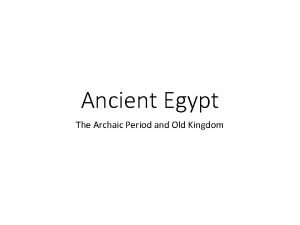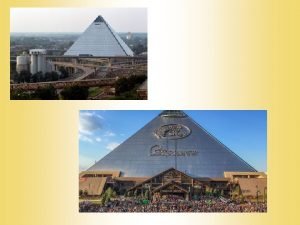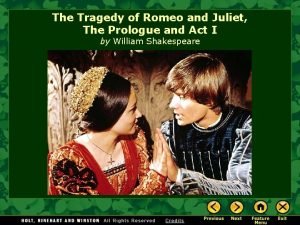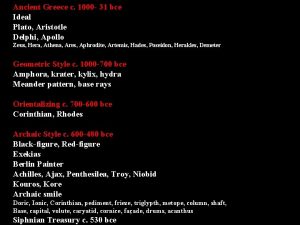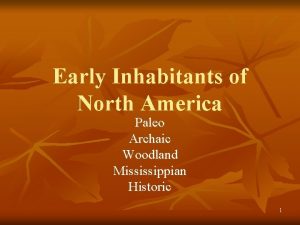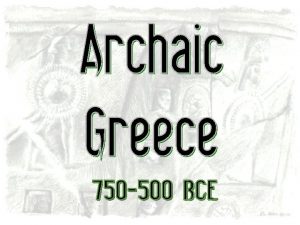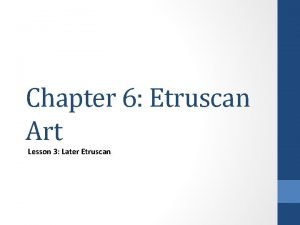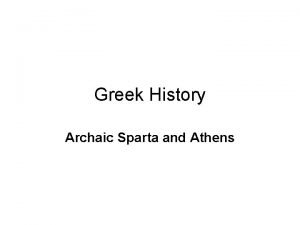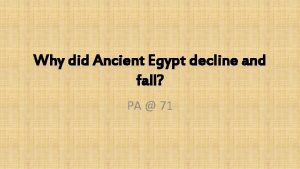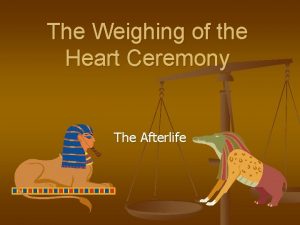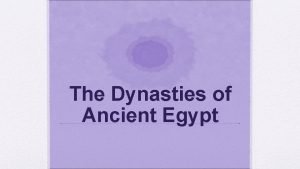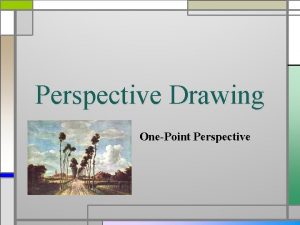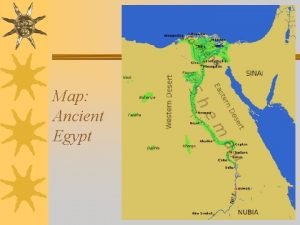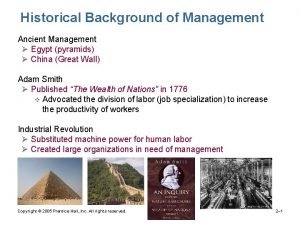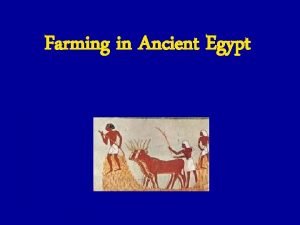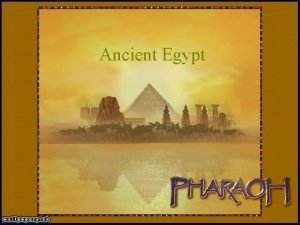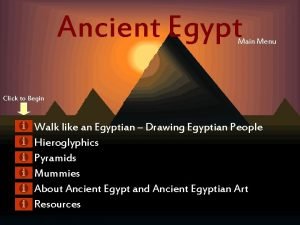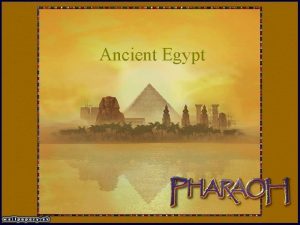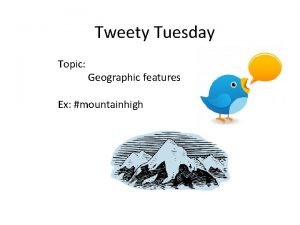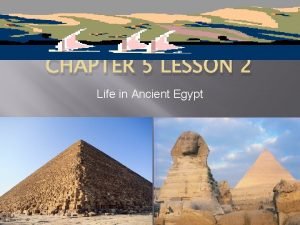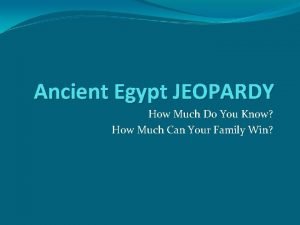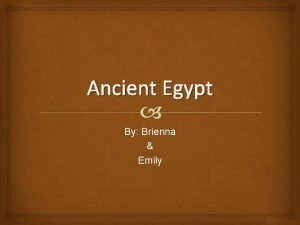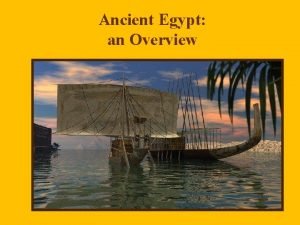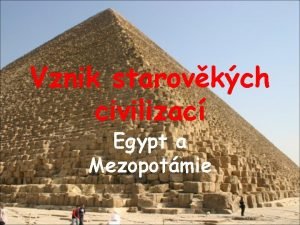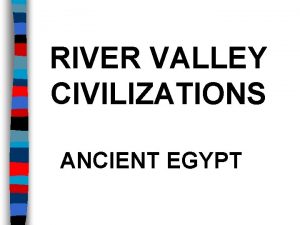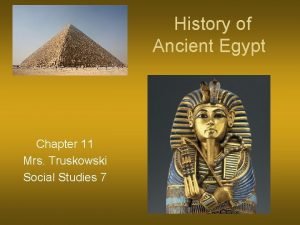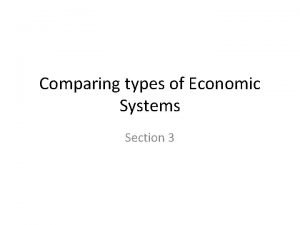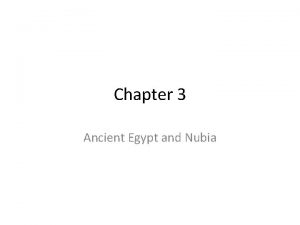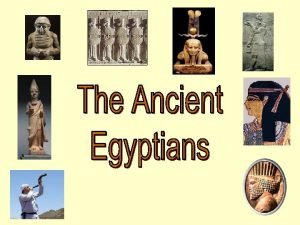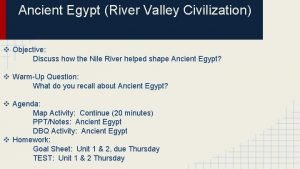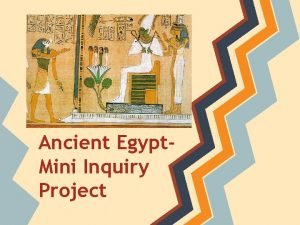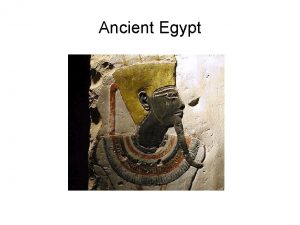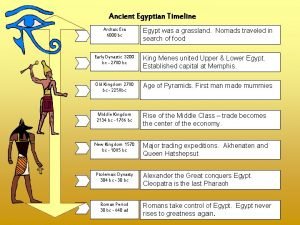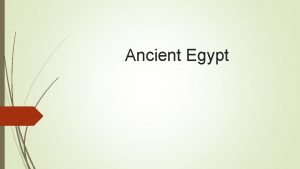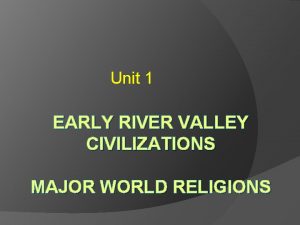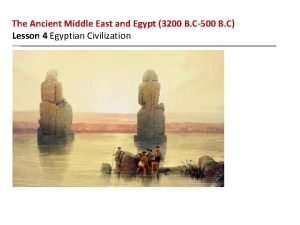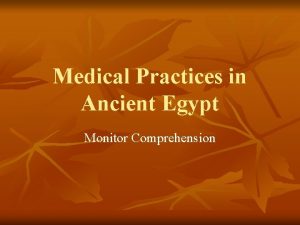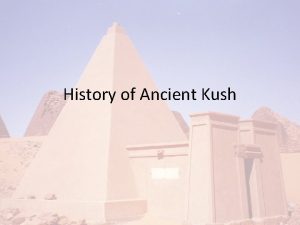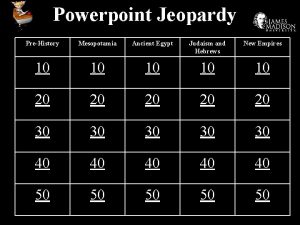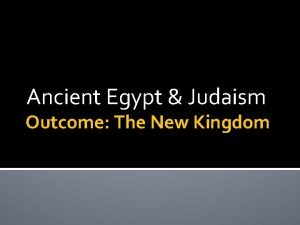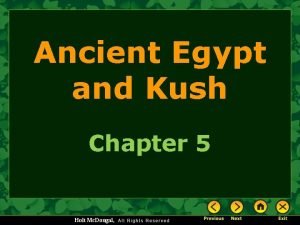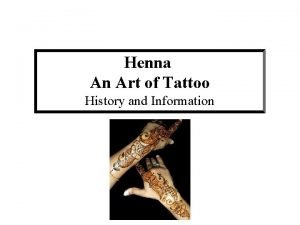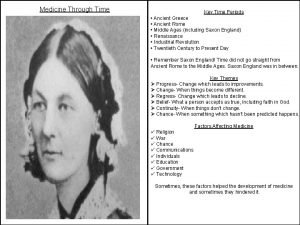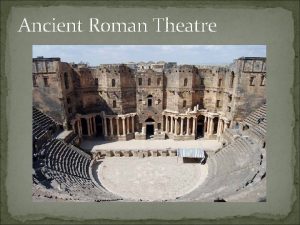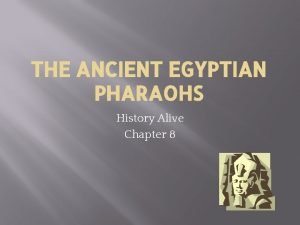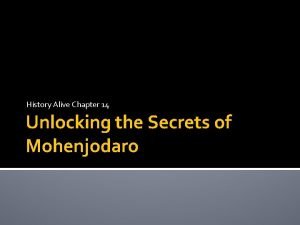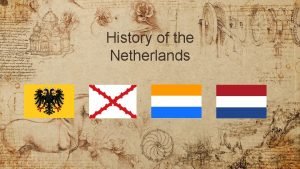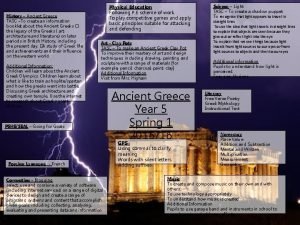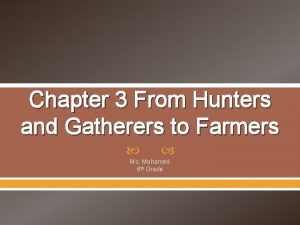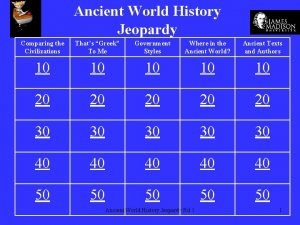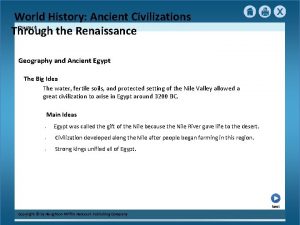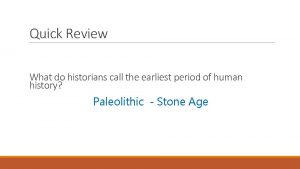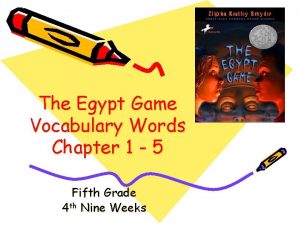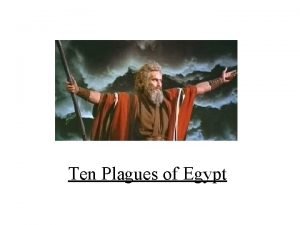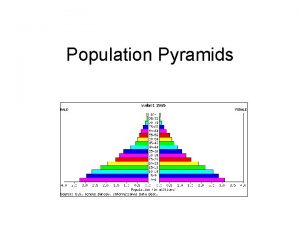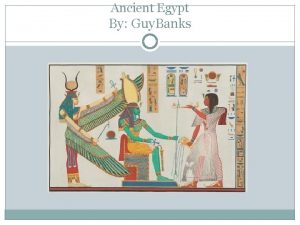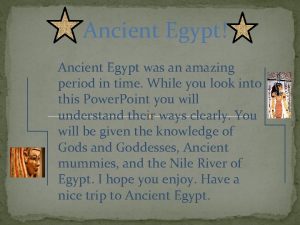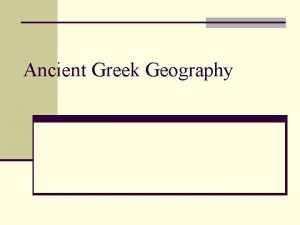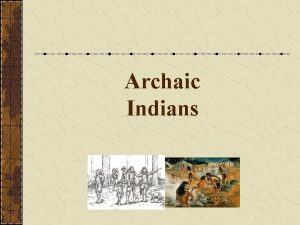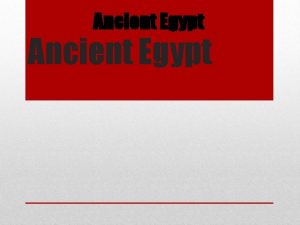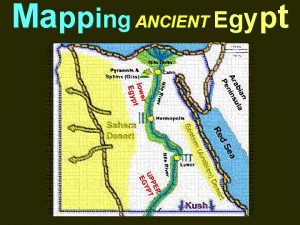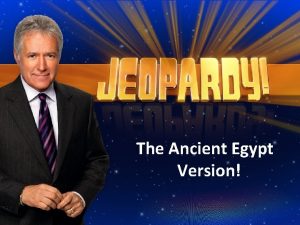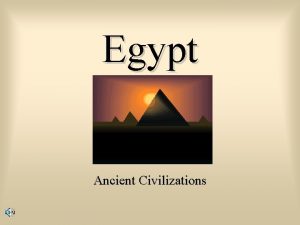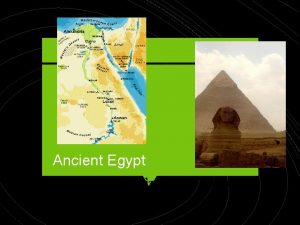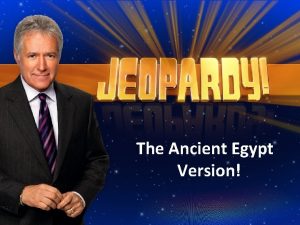Ancient Egypt History n n n Archaic Period









































































































- Slides: 105

Ancient Egypt

History n n n Archaic Period: 3000 -2686 B. C. E. Old Kingdom: 2686 -2181 B. C. E. First Intermediate Period: 2181 -2055 B. C. E. Middle Kingdom: 2055 -1650 B. C. E. Second Intermediate Period: 1650 -1550 B. C. E. n n New Kingdom: 1550 -1069 B. C. E Third Intermediate Period: 1069 -644 B. C. E. Late Period: 664 -332 B. C. E. Graeco-Roman Period: 332 B. C. E. - C. E. 395 n Ptolemaic Period: 332 -30 B. C. E. n Roman Period: 30 B. C. E. 395

History n From prehistoric times, there were 2 opposing kingdoms: n n Lower Egypt (in North) Upper Egypt (in South)

History n Circa 3100 B. C. E, King Narmer united these 2 kingdoms this begins the Archaic Period of Egyptian history

Old Kingdom n Archaic Period began the Old Kingdom. n n n Set up capital at Memphis Created ample wealth Huge building projects exhausted the newly created wealth n Pyramids of Giza

Old Kingdom - Pyramids n n Third Dynasty 2650 BCE: Earliest known pyramid in Egypt built for Djoser n The Step Pyramid

Old Kingdom - Pyramids n n Fourth Dynasty 2613 -2589 BCE: Rule of Snefru. n n Bent Pyramid built in honor of him Angle was changed halfway through construction because original angle was too steep to support the weight

Old Kingdom - Pyramids n n Fourth Dynasty 2575 BCE: Great Pyramid of Giza built n n Tomb for Khufu (Cheops) 479 feet tall

Old Kingdom - Pyramids n n Fourth Dynasty 2532 BCE: Second largest of Pyramids of Giza built n n Tomb for Khafre 470 feet tall

Old Kingdom - Pyramids n n Fourth Dynasty Circa 2500 BCE: smallest of 3 Pyramids of Giza built n n Tomb for Menkaura 215 feet tall

Old Kingdom-The Great Sphinx n n Historians do not agree on the background of the Great Sphinx Who was the model for the face? Who built it? When was it built?

Old Kingdom-The Great Sphinx n n n Most common story: Built by Khafre to guard his pyramid Head of a human with body of a lion NOT unique to Egyptian culture

Old Kingdom. Pyramids/Sphinx

Old Kingdom-The Great Sphinx

Old Kingdom-The Great Sphinx

Old Kingdom. Pyramids/Sphinx

Old Kingdom. Pyramids/Sphinx

Old Kingdom-The Mummy n n Mummification was very important for a person’s/pharaoh’s journey into the afterlife Gods need to be able to recognize the appearance and soul of the individual

Old Kingdom-The Mummy n 1. 2. 3. 4. 5. 6. 7. The Egyptian Soul is comprised of 7 parts Ren Sekem Akh Ba Ka Sheut Sekhu

Old Kingdom-The Mummy § Ren - A person’s name. Given at birth and lives as long as it is spoken Bob Bob § Why there was an importance in placing a name in a lot of writings Bob Bob Bob

Old Kingdom-The Mummy n Sekem - Energy or Power of a person who has died

Old Kingdom-The Mummy n Akh - combination of the Ba and Ka n Possibly a ghost

Old Kingdom-The Mummy n n n Ba - Personality. Closest in comparison to the western idea of soul Makes one unique Lives on after the body dies

Old Kingdom-The Mummy n Ka - the life force n n Death occurs when the Ka leaves the body Ka is maintained through food and drink n Food and drinks often brought to the dead or left with coffin

Old Kingdom-The Mummy n n Sheut - the shadow. Always present Cannot exist without a person, a person cannot exist without a sheut

Old Kingdom-The Mummy n Sekhu - The physical body.

Old Kingdom-The Mummy n Process of mummification perfected in Old Kingdom

Old Kingdom-The Mummy n Yearly flooding of the Nile makes mummification possible n n Leaves behind pools of water Water evaporates and leaves white crystals natron n Natron absorbs moisture

Old Kingdom-The Mummy Original mummification process took 70 days 1. Abdomen slit open 2. Organs removed, but preserved 3. Brain pulled out with long hook through the nose n

Old Kingdom-The Mummy 4. Body cavity stuffed with sacks of natron 5. Entire body covered in natron - or soaked in solution 6. Body cavity washed out 7. Aromatic oils applied to body

Old Kingdom-The Mummy 8. Body cavity stuffed with straw, grass, sawdust, or wads of linen 9. Body wrapped in wet bandages of linen

Old Kingdom-The Mummy n During mummification, internal organs were kept safe and preserved in canopic jars n n Heart remained in body Believed this was where the Ka resided

Old Kingdom-The Mummy n Canopic Jars - images of the 4 sons of Horus n n Imset - (human) - contained the liver Hapi - (baboon) - contained the lungs Duamatef - (jackal) contained the stomach Kebechsenef - (falcon) contained the intestines

Old Kingdom n n Sixth Dynasty No written records as to why Old Kingdom came to an end n n Evidence of mass burials, war, famine, disease Some skeletons found in awkward positions (woman covering child, man covering both) - obviously not buried

First Intermediate Period n n Dark times (few written records) One possible theory: Dramatic reduction in rainfall, reduced the flooding of the Nile

First Intermediate Period n Rival families created separate capitals n n Herakleopolis Magna (Greek) - Lower Egypt Thebes - Upper Egypt

First Intermediate Period n Central authority had broken down because: n n financial trouble No strong political center Rival claims to throne Lack of artistic standardization

Middle Kingdom n n 2055 B. C. E. : Egypt was reunited by prince of Thebes. Mentuhotep II 11 th and 12 th Dynasties gained importance n God, Amun, stressed

Middle Kingdom n n Egypt expands boundaries Referred to as Ancient Egypt’s “Classic Age” n High quality art, literature, language

Middle Kingdom n 11 th-14 th Dynasties: Many military campaigns against Nubia during this time

Second Intermediate Period n n 1640 B. C. E. : Princes of the Asiatic peninsula (Palestine) take control in Lower Egypt Took advantage of weakening political structure

Second Intermediate Period n n Known as the Hyksos Semitic People (Israel, Palestine area) Introduced the war-chariot Split Egypt n South still ruled by Egyptians in Thebes

Second Intermediate Period n n 15 th Dynasty - Ruled by Hyksos 16 th Dynasty - Ruled by Hyksos

Second Intermediate Period n n n 17 th Dynasty Rulers from Thebes used the war-chariot against the Hyksos Defeated the Hyksos and reunited Egypt

The New Kingdom n 1530 B. C. E. : Thebans reunite Egypt

The New Kingdom n n n 18 th Dynasty Warrior-pharaohs created the strongest empire in Egypt’s history Empire stretched from Nubia to the Euphrates River

The New Kingdom n Egypt becomes richest and most powerful country in the ancient world

The New Kingdom n Much of the country’s wealth went into great building projects to honor gods and Pharaohs

The New Kingdom n n Kings/Pharaohs no longer buried in pyramids All buried in The Valley of the Kings

The New Kingdom n Valley of the Kings was created to protect the pharaohs from grave-robbers and defacing

The New Kingdom n Valley of the Kings is the home of King Tutankhamun’s tomb n KV 62

Diagram of Tut’s Tomb

KV 62

KV 62

Into Tut’s Tomb

Tut’s “Treasury”

Tut’s “Burial Chamber”

The New Kingdom n Valley of the Kings’ most impressive tomb n n KV 5 Tomb of sons of Ramesses the Great 120 known rooms Ramesses the Great is in KV 7

The New Kingdom n Valley of the Kings is home to Ramesses, Horemheb, Seti I, Amenhotep I, Hatshepsut, and Tut

The New Kingdom n 1390 -1353 B. C. E. : Amenhotep III stressed arts and architecture

The New Kingdom n Temple of Amun at Karnak was built

The New Kingdom n Hatshepsut n n n Female Pharaoh Stepson, Tuthmosis III, was very young when he inherited the throne Named herself co-regent; eventually took total control Very competent & ambitious - inspirational Ruled for 20 years

Hatshepsut’s Tomb

The New Kingdom n 1353 -1335 B. C. E. : Amenhotep III’s son, Akhenaten weaken’s empire n Armana Period

The New Kingdom n Akhenaten was very offensive to many citizens because: n n Moved capital to new city - he had named Akhetaten Wanted to change the national religion

The New Kingdom n n Akhenaten name means “One who works for Aten” Tried to make Aten the supreme deity n n People used to worship Amun Identified with Ra

The New Kingdom n n Akhenaten’s images are interesting when compared to the art that had emerged – shown seeming very feminine; wide hips, elongated and delicate facial features Assume that they are accurate and show birth defects

The New Kingdom n Tutankhamun Akenaten’s son n n Name means “living image of the god Amun” Took the throne at 8 years old Guided by advisors - one of which was Horemheb Died at 18 years old

The New Kingdom n n n Not a very influential pharaoh Only famous because of completely intact tomb Discovered by Howard Carter in 1922

The New Kingdom n Cursed? n n n Lord Carnarvon and Howard Carter finally enter tomb on February 17, 1923. March 6: Carnarvon bitten by mosquito April 5: Carnarvon died n (supposedly his dog died back in London at the same time)

The New Kingdom Event # of People Present # of those dead in 10 yrs Opening of Burial Chamber 26 6 Opening of Sarcophagus 22 2 Unwrapping of Mummy 10 0

The New Kingdom n Howard Carter died March 2, 1939 of lymphoma (cancer of lymph nodes)

The New Kingdom n After Tut died, Aye married his widow (Ankhesenamun) and took over n n (Ankhesenamun also the name of the queen in The Mummy) Followed by a powerful general - Horemheb

The New Kingdom n n n 1319 -1292 B. C. E. Horemheb restored power and glory to Egypt Reopened temples Strengthened military

The New Kingdom n n “Ramesside” pharaohs follow Horemheb 1292 -1075 BCE: 19 th 20 th Dynasties (11 pharaohs are called Ramesses)

The New Kingdom n n 19 th Dynasty founded by Ramesses I Seti I took over n n Reinstated the work and dedication of Horemheb Ramesses II (Seti I’s son) continued father’s work

The New Kingdom n Seti I & Ramesses II are the only pharaohs to be circumcised

The New Kingdom n n Ramesses II is also known as Ramesses the Great Very long and energetic career (67 years)


The New Kingdom n Ramesses the Great is the pharaoh mentioned in the Old Testament of the Bible n Exodus - The escape of Israelites who had been enslaved by Egyptian ruler

The New Kingdom n Ramesses the Great fathered 40 daughters and 45 sons

The New Kingdom n His court wanted to preserve Ramesses the Great’s famous hooked nose as a mummy n Stuffed his nasal cavities with peppercorns

The New Kingdom n n 20 th Dynasty All pharaohs named Ramesses

Third Intermediate Period n n n 21 st Dynasty High Priest of Amun at Thebes Splits Egypt in 2 again

Third Intermediate Period n n Priesthood of Amun in control of Upper Egypt Smendes I controlled Lower Egypt

Third Intermediate Period n 1075 BCE: Lybian invaders seized Lower Egypt

Third Intermediate Period n n n 24 th-25 th Dynasty 750 BCE: Nubian king Piye reunites Egypt Begins the final era of rule by Egyptians

Third Intermediate Period n n 30 th Dynasty Last native-Egyptian ruling family of Egypt

Late Period n 525 -332 BCE: Egypt is ruled by Persians n Persians allow Egypt to maintain Pharaonic tradition

Graeco-Roman Period n n 332 -30 BCE: Egypt is ruled by Greeks 332 BCE: Alexander the Great conquered Egypt n Recognized as a pharaoh for liberating them from Persian control

Graeco-Roman Period n Alexander built the city of Alexandria on Egypt’s northern coast of the Mediterranean

Graeco-Roman Period n n Alexandria became the intellectual center of the world Museum and Library are said to have held all important intellectual achievements of the ancient world

Graeco-Roman Period n Lighthouse at Alexandria is considered 1 of the Seven Wonders of the Ancient World

Graeco-Roman Period n n Ptolemaic Period 323 BCE: Alexander died Territories were divided amongst his generals Ptolemy was given Egypt

Graeco-Roman Period n n Ptolemy’s line lasted 300 years Ptolemy XIII Cleopatra’s powerhungry little brother n Gave Pompey’s head to Julius Caesar

Graeco-Roman Period n n 31 BCE: Battle of Actium was actually a war that Rome declared on Cleopatra Thought she was manipulating Antony into giving her land

Graeco-Roman Period n 30 BCE-CE 395: Egypt ruled in absentia by Romans

Graeco-Roman Period n n n 395 CE: Rome forces the adoption of Christianity Egyptian temples are forced to close Marks the end of Ancient Egypt

Culture/Society

Culture/Society n n Greek historian, Herodotus, called Egypt “the gift of the Nile” Life centered around the Nile River and what it provided

Culture/Society n n n Egyptians called their country, Kemet - means “Black Land” Refers to the fertile black soil on the banks of the Nile River Kemet was surrounded by Deshret - “Red Land”

Culture/Society n Egyptian art focuses on colors of the world around them - blue skies, red desert, golden sun, green river, black soil

Culture/Society n n Egyptians believed very strongly in the balance of opposites: light & dark, order & chaos, male & female This balance was maintained by the gods, goddesses, and king (Pharaoh)

Culture/Society n n Pharaoh - literally means “Great House” and was originally used to signify the buildings of the court or a palace Came to mean the king, himself, in 18 th Dynasty

Culture/Society n Believed that the Pharaoh was a representative of the gods on Earth
 Archaic period egypt
Archaic period egypt Upper egypt and lower egypt
Upper egypt and lower egypt Iambic pentameter in romeo and juliet
Iambic pentameter in romeo and juliet Paleo archaic woodland mississippian
Paleo archaic woodland mississippian Shakespeare archaic words
Shakespeare archaic words Archaic pronouns
Archaic pronouns Dipylon amphora
Dipylon amphora Accent and dialect english language a level revision
Accent and dialect english language a level revision Paleo archaic woodland mississippian
Paleo archaic woodland mississippian The archaic age
The archaic age Archaic painting
Archaic painting Literary coinages
Literary coinages Paleo archaic woodland mississippian timeline
Paleo archaic woodland mississippian timeline Homoioi
Homoioi Why did egypt decline
Why did egypt decline What was the weighing of the heart ceremony
What was the weighing of the heart ceremony Middle ages floral arrangements
Middle ages floral arrangements Egypt vocabulary
Egypt vocabulary What is frontalism in egyptian art
What is frontalism in egyptian art British council introductions
British council introductions Specialized jobs in ancient egypt
Specialized jobs in ancient egypt Ancient egypt
Ancient egypt Outline map of ancient egypt
Outline map of ancient egypt Contingency theory of leadership
Contingency theory of leadership What crops did egypt grow
What crops did egypt grow Ancient egyptian clothing for special occasions
Ancient egyptian clothing for special occasions Ancient egyptian transportation
Ancient egyptian transportation Geographical map of ancient egypt
Geographical map of ancient egypt Ancient egypt social classes
Ancient egypt social classes What is frontalism
What is frontalism Egypt map
Egypt map Social classes in ancient egypt
Social classes in ancient egypt Pyramids of energy transfer
Pyramids of energy transfer Non chronological report about egypt
Non chronological report about egypt How did the nile shape ancient egypt
How did the nile shape ancient egypt Egyptian social pyramid
Egyptian social pyramid Ancient egypt jeopardy
Ancient egypt jeopardy Ancient egypt basic needs
Ancient egypt basic needs The three kingdoms of ancient egypt
The three kingdoms of ancient egypt Achievements of ancient egypt
Achievements of ancient egypt Workbook page 19
Workbook page 19 Ancient egypt specialized workers
Ancient egypt specialized workers Indus valley civilization medicine
Indus valley civilization medicine Ancient egypt timeline
Ancient egypt timeline Economy of ancient egypt
Economy of ancient egypt Map of ancient egypt and nubia
Map of ancient egypt and nubia Ancient egypt bell ringers
Ancient egypt bell ringers Relative location of ancient egypt
Relative location of ancient egypt Ancient egypt civilization geography
Ancient egypt civilization geography How did the nile shape ancient egypt dbq answer key
How did the nile shape ancient egypt dbq answer key Economy of ancient egypt
Economy of ancient egypt Disadvantages of ancient egypt geography
Disadvantages of ancient egypt geography Egyptian religion timeline
Egyptian religion timeline Nile river valley advanced cities
Nile river valley advanced cities Ancient egypt civilization
Ancient egypt civilization Social hierarchy ancient egypt
Social hierarchy ancient egypt Fun facts for greece
Fun facts for greece Medical practices in ancient egypt answer key
Medical practices in ancient egypt answer key Kush and egypt map
Kush and egypt map Ancient egypt slogans
Ancient egypt slogans Mesopotamia jeopardy
Mesopotamia jeopardy Yaru ancient egypt
Yaru ancient egypt Ancient egypt vocabulary words
Ancient egypt vocabulary words Ancient egypt and judaism outcome the new kingdom
Ancient egypt and judaism outcome the new kingdom Ancient egypt drawings easy
Ancient egypt drawings easy Map of egypt and kush
Map of egypt and kush Henna tattoo history
Henna tattoo history Ancient and modern communication
Ancient and modern communication Ancient india vs ancient china
Ancient india vs ancient china Ancient time period
Ancient time period Cynthia lightfoot
Cynthia lightfoot Refractory period
Refractory period Absolute refractory period and relative refractory period
Absolute refractory period and relative refractory period Critical period vs sensitive period
Critical period vs sensitive period Critical/sensitive periods
Critical/sensitive periods Critical period vs sensitive period
Critical period vs sensitive period Classical period 1750 to 1820 romantic period
Classical period 1750 to 1820 romantic period Period 4, metallic, 27 electrons
Period 4, metallic, 27 electrons Activism period
Activism period Stability period vs measurement period
Stability period vs measurement period Trustee period and royal period
Trustee period and royal period Difference between history and prehistory
Difference between history and prehistory Ancient rome theater
Ancient rome theater History alive chapter 8
History alive chapter 8 History alive the ancient world chapter 14
History alive the ancient world chapter 14 Netherlands ancient history
Netherlands ancient history Tasc ancient history
Tasc ancient history From hunters and gatherers to farmers chapter 3 answers
From hunters and gatherers to farmers chapter 3 answers Physical features of punjab pakistan
Physical features of punjab pakistan Cenutar
Cenutar World history jeopardy
World history jeopardy World history ancient civilizations through the renaissance
World history ancient civilizations through the renaissance Period 3 ap world history
Period 3 ap world history Electro-mechanical period
Electro-mechanical period Before written history
Before written history What do historians call the early period of human history
What do historians call the early period of human history Ap world history period 2 test
Ap world history period 2 test History also history physical
History also history physical Egypt angel of death
Egypt angel of death Cataracts of the nile map
Cataracts of the nile map Emco egypt
Emco egypt Babi egyptian god
Babi egyptian god The egypt game vocabulary
The egypt game vocabulary Plagues and egyptian gods chart
Plagues and egyptian gods chart Primate citys
Primate citys Rectangular population pyramid
Rectangular population pyramid
